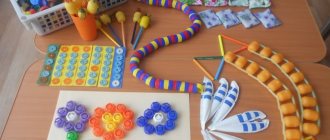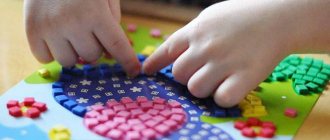As they say, better late than never Many are probably already despairing of waiting for the continuation of the series of articles about the development of fine motor skills But I finally did it! Meet the most useful games that a child over 2.5 years old will definitely enjoy. Games that will make his fingers more dexterous and persistent. And, as we know, this is the key to successful speech development, and the overall development of the baby.
At this age, the child begins to succumb to smaller and smaller movements, his fingers become more agile, and his movements become more accurate. And, if earlier we paid attention to working with tweezers, a pipette, and scissors, now the child can be offered even such small work as fastening buttons and creating sand paintings! Well, first things first.
(If you haven’t read the previous articles with games for two-year-olds (part 1, part 2), quickly follow the links, they will be relevant for a child even at 2.5 years old).
We “walk” along the paths with our fingers
Among the variety of finger games, one of the most useful exercises at this age is considered to be “walking” with your fingers. Do you remember how in childhood we played with little men, who used the index and middle fingers instead of legs? It's time to teach this fun to your children
You can walk with your fingers along paths drawn on paper or along tactile paths made from textured materials (in this case, we also activate the baby’s sensory sensations). To make it more interesting for the child, at the beginning and end of the path you can portray different characters and come up with some interesting task, for example, “Help the mouse get to the cheese.”
You can make sensory paths using a glue gun and materials of different textures. Various types of cereals, beans, pasta, cocktail straws, a dish sponge, and soft pom-poms are perfect for this.
Here are some exercises you can do on the tracks:
- We run our finger along the path (first with the index finger, then you can experiment with others),
- We “jump” along the paths with our index and middle fingers, putting them together,
- We “walk” along the paths with our index and middle fingers,
- You can also play football with your fingers by making a “ball” out of a crumpled napkin (this is just on the table)
For more information about homemade sensory paths, watch our video.
Among the ready-made solutions for “finger walking,” I would like to highlight the “Finger Steps” manual; it also provides exercises for simultaneous performance with both hands.
Components of the regime
To begin with, it’s worth identifying all the important components of the daily routine of two-year-old children:
- Nutrition. At two years old, the number of meals is 4 or 5. If parents eat a healthy and balanced diet, then their son or daughter can be transferred to a common table. But you need to offer dishes that correspond to the age characteristics of the baby.
- Dream. Rest is extremely important, as it allows you to restore strength, absorb and process the information received, and “reboot” the nervous system.
- Development: emotional, physical and intellectual. This component includes active games and gymnastics, various developmental activities, creativity, communication with family members and peers.
- Walks. Fresh air is also essential for well-being and good health.
We stretch the rubber bands on the geoboard
Geometric, also known as geoboard, also known as math tablet (My-shop, KoroBoom) is a fairly popular educational toy these days. I already wrote about it in an article about logic games, and I will repeat it here. Why? Because for a two-year-old child, a tablet is primarily relevant as a simulator for the development of fine motor skills. Do you think it’s easy to stretch and tighten rubber bands on nails? The task is not trivial for a child, but with due diligence the child will definitely master it. The child will be happy to build endless webs, conquering unyielding rubber bands.
And when the skill is mastered a little, you can show your child that it is also interesting to create pictures from rubber bands. Here is a list of the most “hit”, in our opinion, pictures for designing - a comb, a table, a chair, a man, flowers, a Christmas tree, a flag, letters. The pictures are simple and therefore well suited for beginners.
Taisiya and I had the simplest geometrics (as in the photo above), but now the manufacturers have gone further - in the kit of some geoboards you can also find cards with tasks! The essence of the tasks is for the child to complete existing pictures using rubber bands. I really like this “addition”, because it makes the geoboard even more accessible to kids. This is a wonderful preparatory stage for the independent construction of paintings.
Guessing pictures and textures by touch
Remember, in the article about games for the development of motor skills from 2 years old, I mentioned the game “Magic Bag”. This activity, as a rule, always goes off with a bang! Because it contains an element of surprise, and children love this passion. But it is worth noting that in addition to positive emotions, the game also stimulates sensory perception, because in the process of playing the child learns to identify objects by touch.
If you have already mastered the tactile games from the previous article, I suggest you try more advanced options for developing sensory sensations.
Option 1. Tactile pictures
You can make tactile pictures yourself using velvet colored paper (it is sold at any stationery store). To do this, cut out silhouettes of simple pictures from velvet paper and paste them onto cards made of ordinary colored cardboard. Thus, the pasted picture will differ from the card itself in texture. It is also desirable that the shapes of the pictures differ noticeably from each other. I took ideas from simple coloring books I downloaded on the Internet.
When the cards are ready, let your child feel each of them first. And then ask him to close his eyes and guess by touch any of the cards you offer. Repeat the game with other cards.
Option 2. Touch lotto
Unlike regular lotto, in sensory lotto the child is asked to find the same chips not visually, but tactilely. You can buy a lotto ready-made or make it yourself, armed with a glue gun, baby food lids and various textured materials (for example, cereals, beans, pompons, velvet paper, beads, sponge). See the video for an example of a homemade lotto.
If your child has never played with tactile lotto before, then first just look and feel all the chips, discuss which ones are soft, which ones are rough, prickly, smooth, etc. And after you have studied it thoroughly, offer to play the “Magic Bag” by putting a small amount of chips into it. The child’s task is to find in the bag by touch exactly the same chip that you show him.
Social and emotional development of a 2.5 year old child: how does the child behave?
- Maintains an emotionally balanced state during periods of wakefulness.
- Shows specific properties: cheerful, active, restless, noisy, inquisitive, indifferent, calm, lethargic, capricious, etc.
- Can determine its condition. Perceives his individuality through his own emotional sensations: I’m in pain, I’m having fun, I want to, etc.
- Long-term emotional memory appears. He remembers his previous emotional feelings when he finds himself in different situations: at a holiday, at a party - it’s fun; when sick - unpleasant, bad.
- Sometimes he is emotionally restrained when giving instructions: “need”, “must”, “wait”, etc. (awareness of the situation based on emotional experience).
- Enjoys an interesting game (difficult to distract). Emotionally interested. Calmly performs familiar actions.
- Rejects uninteresting, incomprehensible games (it’s difficult to attract action if you don’t get interested).
- He becomes upset and angry at his failures when performing an unfamiliar action.
- Rejoices and laughs when receiving results, performing familiar actions.
- Enjoys fun games with adults and children.
- Experiences emotional pleasure (the emergence of aesthetic feelings) while listening to familiar pieces of music and songs.
- Recognizes familiar music and reproduces familiar movements (alone and with a group of children).
- Experiences joy and delight when performing dance movements.
- Begins to feel beauty.
- Subtle emotional states are inherent: tenderness, love for one's neighbor, sympathy, pity, resentment, envy, melancholy, joy, anger (aggression), fear, interest in the animal and plant world, and natural phenomena.
- Needs a friendly attitude from adults and their positive assessment.
- The feeling of attachment to mom, dad, and close adults remains. He gets worried when they leave, but quickly calms down.
- Emotionally empathizes with a loved one in understandable situations.
- Able to understand the joy or sadness (upset) of another child.
- Evaluates adults (“bad”, “good”) depending on their emotional and individual character traits and attitude towards him. Feels strong and weak-willed people in the family. Behaves differently with them (submits or disobeys).
- Cannot always appreciate kindness or understand punishment.
- He is wary when communicating with unfamiliar adults, but easily makes contact if they have a friendly attitude.
- Imitates unfamiliar people, situations if emotions are deeply affected (playing at the theater, going to the clinic, etc.).
Learning to fasten buttons
As you know, the main motto of Maria Montessori’s method is “Help me do it myself.” This means that we offer the child feasible tasks to complete independently, we suggest, guide his hand, if necessary, but we try to interfere with his activities to a minimum. And this applies not only to games, but, first of all, to self-service skills. Yes, yes, even toddlers can be entrusted with simple tasks of caring for (and cleaning) themselves (eating with a spoon, fastening zippers, sweeping up crumbs with a dustpan, etc.). After all, mastering self-care skills for a child is an activity no less interesting (and useful!) than any game.
Since he was a year old, we have been asking the baby to unfasten zippers, Velcro, and unscrew lids, and we remember how the baby enthusiastically “hovered” over this activity. Well, now it’s time to trust the child to fasten the buttons on his own. Of course, it will be difficult for a child to immediately deal with the buttons on his blouse; it is better if first it is something like a button simulator, or at least your blouse with large buttons.
If you have the time and desire, then you can sew a button simulator yourself, designing it, for example, in the form of doors that close with a button, or some character with fastened clothes. Such toys will make mastering “button making” incredibly interesting for a child, because not everyone immediately wants to pick up a jacket
You can also look for ready-made button exercise machines that are currently on sale.
While playing, explain that it is more convenient to hold the button with your thumb and forefinger, first pointing one side of it into the loop. Hinged hinges are usually more difficult for a child to master, so start with slotted ones.
Mode of a child not attending kindergarten
If the child is still sitting at home and does not attend a general education preschool institution, then his regime may be something like this:
| Time intervals | Actions |
| From 7:30 to 8.00 | Waking up, changing clothes, hygiene procedures (washing and brushing teeth) |
| From 8.00 to 8:15 | Morning exercises |
| From 8:15 to 8:30 | Breakfast |
| From 8:30 to 9.00 | Preparing for the walk |
| From 9.00 to 10:30 | Morning walk |
| From 10:30 to 12.00 | Leisure at home: games, activities, creativity |
| From 12.00 to 12:30 | Dinner |
| From 12:30 to 13.00 | Preparing for the day's rest |
| From 13.00 to 15.00 | Dream |
| From 15.00 to 16.00 | Waking up, changing clothes, quiet games, communicating with family members, preparing for afternoon snack |
| From 16.00 to 16:30 | Afternoon snack |
| From 16:30 to 18:00 | Walk |
| From 18.00 to 18:30 | Games, activities |
| From 18:30 to 19.00 | Dinner |
| From 19.00 to 20.00 | Quiet entertainment at home, communication with family |
| From 20.00 to 20:30-20:40 | Getting ready for bed: light snack if desired (a glass of kefir or milk), hygiene procedures (bathing and brushing teeth), putting on pajamas |
| From 20:30-20:40 to 21:00 | Setting the mood for sleep: reading a fairy tale or singing a lullaby, calm conversations, stroking the head |
| From 21.00 to 6.00-7.00 | A good night's sleep |
The daily schedule presented above is approximate. It is necessary to create and organize a regimen taking into account the individual needs and characteristics of each specific child. So, if the baby wakes up later or earlier, then awakening and, accordingly, going to bed at night may shift. Still, you should adhere to the recommended intervals between activities so that the periods of wakefulness and rest are not too short or, on the contrary, long.
Learning to hammer nails with a hammer
No, we’re not talking about dad’s hammer and nails. For this purpose, there are special children’s construction sets with a small wooden hammer and button nails (Ozon, My-shop, KoroBoom). I’ll say right away that such construction toys are always marked 3+, or even 5+, and some mothers generally try to avoid such toys for safety reasons. You, of course, know that I’m not one of them. I’m not ready to give up such games completely, because they’re just a HIT for a child 2.5 years old (and older)! But, of course, we always play under strict supervision.
This activity, first of all, develops the coordination of the baby’s movements - you need to install and hold the nails with one hand, and hammer them in with the other. Plus, you can learn to create a variety of shapes from construction kit parts.
Tables of height and weight of a child at 2.5 years old
The table presents data on the norms of weight and height of a child at 2 years 6 months according to the observations of domestic pediatricians.
| 2 years 6 months | Bottom line | Upper limit |
| Boys' weight, kg | 12,0 | 16,3 |
| Girls' weight, kg | 11,7 | 15,5 |
| Boys' height, cm | 87,0 | 97,1 |
| Girls' height, cm | 86,0 | 96,5 |
Data from the World Health Organization on the parameters of physical development of children at 2.5 years of age
| 2 years 6 months | Bottom line | Upper limit |
| Boys' weight, kg | 10,5 | 16,9 |
| Girls' weight, kg | 10,0 | 16,5 |
| Boys' height, cm | 85,1 | 98,7 |
| Girls' height, cm | 83,6 | 97,7 |
| Boys' head circumference, cm | 46,1 | 51,7 |
| Head circumference of girls, cm | 45,1 | 50,7 |
Assembling pictures by overlaying elements
Despite the fact that to prepare this game you only need a marker and sour cream lids, it develops spatial and logical thinking no worse than the well-known Bondibon. Therefore, stock up on sour cream and get started!
What is the essence of the game? The child needs to assemble a whole picture from individual parts drawn on the lids. This is a completely new problem for a child’s spatial thinking, because when playing with blocks or construction sets, he is used to getting a certain image or shape by putting the parts together. Here the picture will be obtained by superimposing transparent parts on top of each other.
To play the game, you will need to prepare several simple picture diagrams and draw the corresponding elements on the transparent covers. For example, on one cover we draw a house, on another – a fence, on the third – the sun, on the fourth – grass. If you combine all this, you get a beautiful village landscape. Elements of different pictures must be mixed together so that the child himself can select the appropriate ones, focusing on the diagram. You can see the essence of the game in more detail in the video.
Playing with a balancer
How is a balancer useful? First of all, it develops coordination and accuracy of movements. After all, installing cylinders on scales is not the easiest task for a child; it requires significant concentration and clarity of movements.
In addition, many balancing games (which contain cubes and cylinders of different colors) can be used as a first board game. I wrote about this in detail in an article about board games, so I won’t repeat it.
Playing with small mosaic pieces
Any mosaic is an excellent trainer for a child’s fine motor skills. And if earlier, a year, one of the child’s main toys was a mosaic with large chips, now he can be offered a mosaic, which many of us probably remember from childhood - with small details on tiny legs (Ozon, My-shop, KoroBoom ).
The very process of pushing the thin plastic legs into the tiny holes is very exciting for the baby. There is no need to rush the child by asking him to immediately draw a picture; let him calmly learn a new skill. And when the construction of abstract images is already easy, try to involve your child in the construction of paths and simple figures.
Taisiya liked most of all to build bridge paths between two small toys placed at the edges of the playing field. The paths may not be of chaotic colors, but with a certain pattern (alternating colors through 1, through 2 or more complex patterns) - this is how we immediately develop logical thinking.
Nutrition
A two-year-old eats at least 4 times a day, but if desired, you can add an additional meal, for example, in the form of a second light breakfast-snack between the main breakfast and lunch.
The diet should include the following products in certain quantities:
- wheat bread – 60-70 g
- rye bread – 30 g
- pasta or cereals (dry) – 40 g
- meat – 60-70 g
- fish – 60-70 g
- potatoes – up to 100-150 g
- other various vegetables – 150 g
- cottage cheese – up to 80-100 g
- milk – 200 g
- yogurt or kefir – 200 g
- cottage cheese – up to 100 g
- butter - a tablespoon;
- vegetable oil - a tablespoon;
- sour cream - a teaspoon;
- eggs – a whole small egg;
- dried fruits – 10-15 g
- hard cheese with a fat content of 45% - a five-gram piece.
Let's look at a sample menu for one day in the table:
| Eating | Dishes (examples) |
| Breakfast | 60 g steamed omelette, 150 g porridge cooked in milk, 150 ml tea or juice |
| Dinner | 100 ml of vegetable soup, steamed cutlet (60 g), 50 g of vermicelli, 50 g of seasonal vegetables (in the form of a salad dressed with sour cream or butter), 150 ml of compote (for example, from dried fruits) |
| Afternoon snack | 100 grams of yogurt or kefir, 50 g of cookies or rolls, fruit (apple, pear, peaches) |
| Dinner | 100 g mashed potatoes with butter, 100 g vegetable stew, 50 g fish (soufflé, cutlet) |
There is no longer a need for breastfeeding at two years old, but the mother can breastfeed if the baby needs it.
Making sand paths and sand paintings
When I first suggested that my daughter make a sand path (or rather, we had semolina paths), I didn’t even expect that she would be so interested. And she happily took up the idea and began enthusiastically making paths between the hippopotamus and the elephant, between the hare and his house... In general, she was unstoppable
The child’s task in this game is to help the animals get to some goal by making them a real embankment path. You will need to draw the boundaries of the path in advance or lay out them from counting sticks / matches. Well, the child will already fill all the paths with “sand”, having previously smeared them with glue (glue - according to your desire, you can do without it). Semolina is best suited for the role of sand. Or if you have colored sand, you can use that.
During the game, fine motor skills develop perfectly - the child learns to make neat, directed movements with a pinch. And, of course, imagination, creative thinking develops, and your mood simply improves!
The next level, for those who are especially keen, is creating simple sand paintings. Surely, you have come across kits for sale for creating such paintings (they are also called frescoes). Just don’t buy complex paintings right away! To begin with, use only small pictures with large details.
Playing with a magnetic maze
Well, a couple more interesting toys that are suitable for ages 2.5 years and older
Firstly, this is a magnetic labyrinth (Ozon, My-shop, KoroBoom). I don’t want to repeat the hackneyed “develops fine motor skills,” but this is true. A child learns to guide balls through a maze using a magnetic stick. In this case, the stick must be held strictly vertically and pressed tightly against the surface of the labyrinth, but this is not easy. The ball will come unhooked, but the stick will not want to give in, so the baby will have to make every effort.
There are different labyrinths. Some are built in such a way that all the balls need to be brought to one “finishing” place, in others there are several such places, and some even involve playing with an opponent (for example, football) and contain two sticks for the game at once.







